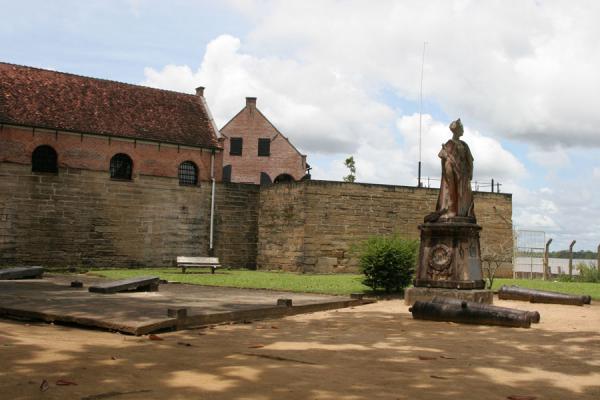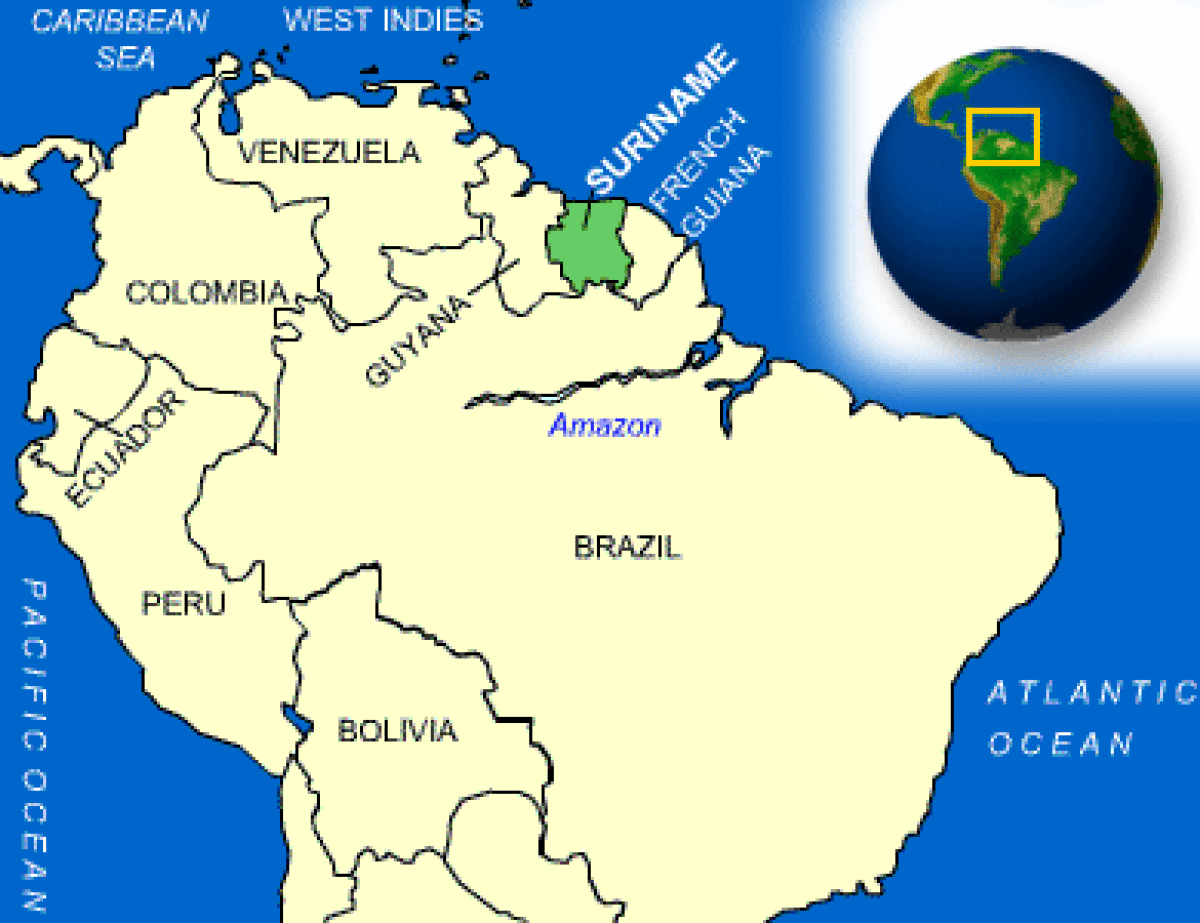If you’ve ever looked at a map of South America, there are three small countries in the top right corner. The one on the left is Guyana, which I covered already. The one on the right is French Guiana, which is one of France’s overseas territories. And the one in the middle is Suriname. While most of South America speaks Spanish or Portuguese, these three are the ones that are outliers. Guyana’s official language is English, French Guiana is French, and Suriname is Dutch.
Its name is most likely based on the name of the indigenous people, Surinen. When the British arrived, they set up settlement on the Suriname River, except they spelled it Surinam. However, the Dutch changed the English spelling by adding the final “e” to the name. Even at that, the version without the “e” still exists in certain instances and names. In Dutch, however, it’s pronounced something like “soo-ri-NAH-muh.”
As I mentioned, Suriname is located on the northeastern coast of South America. It’s bordered by French Guiana to the east, Brazil to the south, and Guyana to the west. Its coast touches the Atlantic Ocean. Culturally, it’s considered part of the Caribbean community and one of the few mainland countries to be part of it. The land is fairly diverse, with low mountains, savannahs, and rainforests. Because the country lies only a few degrees north of the equator, it has a tropical climate and is quite humid (there are probably no good hair days here.)
 |
| part of Fort Zeelandia in Paramaribo |
The Arawak and Carib tribes were the first inhabitants in Suriname, first arriving around 3000 BC. During the 16th century, the Europeans really started moving into Caribbean, doing the usual things: exploring, exploiting, stuff like that. The British, Spanish, and French were the first to really sweep through the Caribbean, but the British and Dutch were the main ones creating communities in this area where Suriname is. And as expected, they butt heads over who controls what in the Western Hemisphere, eventually leading to a treaty granting the English access to what’s now New York City, and the Dutch access to what’s now Suriname (that’s one helluva deal). By the late 1600s, the Dutch started bringing in African slaves to work their plantations. The thick rainforests helped make it easier for many of these African slaves to escape, and with the help of other native tribes, they were able to establish their own tribes. Called Maroons in English, these Maroons often raided the plantations to recruit others, which led to quite a bit of hostility between the two groups. Slavery was abolished at the same time it was in the US, but the emancipation process took about a decade to fully put in place since their economy was largely based on their mega plantations. To help with this shortage of exploitable labor, the Dutch brought in large numbers of laborers from India and Indonesia to take up some of the slack (you know, other brown people, but this time they didn’t “own” them). During WWII, the US actually set up camp in Suriname to protect the bauxite mines (one of the main sources for aluminum). During the middle part of the 20th century, Suriname began talks of independence, which was finally granted in 1975. Their early years weren’t easy; by 1980, they underwent a military coup with several counter-coups that followed. Even today, there is still corruption and scandals attached to leading officials, but you know, what’s new.
The capital of Suriname is Paramaribo, a coastal city of roughly 250,000 people. Nearly 90% of the people live in this city or along the coast. The city lies at the mouth of the Suriname River and is named for the Paramaribo tribe who lived there originally. It stems from the Tupi-Guarani words for “large river” and “inhabitants.” The city is fairly diverse, having significant populations of Asian (Indonesian, Chinese, Indian), European (Dutch, Portuguese), African/Maroons, Lebanese, mixed race, Brazilians, and Guyanese. The historical part of the inner city is listed as a UNESCO World Heritage site.
Although agriculture is one of their higher economic drivers (mainly in rice, shrimp, and bananas), bauxite mining remains as one of their more important sources of revenue. Tourism and especially ecotourism are high, with most of the tourists coming from the Netherlands. They also have some gold and oil as well. However, with the instability of the government, the stability of their economy has been affected because of this too. Although they saw some steady growth during the 1990s, it’s kind of slowed down in the past 20 years or so.
Roughly half the people are Christians in Suriname, mainly Roman Catholic, Pentecostal, Moravian and other Protestant denominations. Because of the large numbers of Indian immigrants, Hinduism is also a significant religion in Suriname, along with a large number of the Indonesian and Indian populations who practice Islam. A few other religions are practiced (like various Afro-American beliefs) and a few people who don’t adhere to anything.
Over 60% of the people speak Dutch, which is the official language, and the other 40% of the people speak it as a second language. Sranan Tongo is an English-based creole used as a vernacular language, spoken mainly by the Creole population and generally used in the streets. Caribbean Hindustani is also used by people who were originally from India and surrounding areas, which is actually a dialect of Bhojpuri. Several of the Amerindian languages are still used along with English, Chinese, and Portuguese.
Suriname has a low population compared with other countries in South America, and part of that is because nearly 90% of the country is covered in rainforest. It’s also known for its flora and fauna: it has more than 1000 species of trees, and it’s known for having large numbers of orchids, water lilies, bougainvillea, hibiscus, and oleanders. It’s also known for the tapir, the largest mammal in Suriname and one of the weirdest looking animals period. But what’s not weird is their food, and I’m super excited to make some next week.
Up next: art and literature
.JPG?format=1500w)






No comments:
Post a Comment